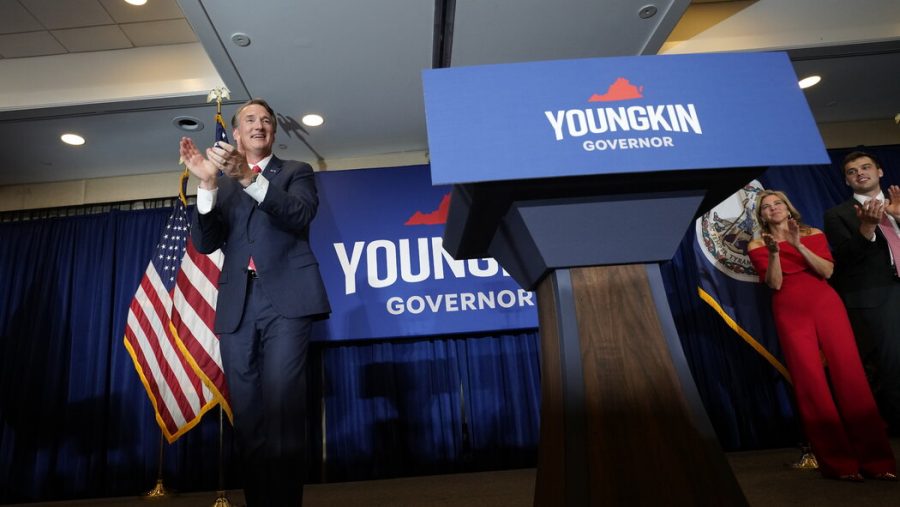Youngkin Wins Virginia’s Gubernatorial Race
Youngkin addresses supporters after his win in Virginia on Tuesday.
All political eyes were on Virginia Tuesday night as voters decided whether they were going to elect Terry McAuliffe (D) or Greg Youngkin (R) as their next governor. Gubernatorial elections in the Commonwealth are peculiar because governors are prohibited from serving two consecutive terms. This led to current governor Ralph Northam having to step back, while McAuliffe and Youngkin fought for his seat.
McAuliffe, elected governor of Virginia in 2013, sought to make the race a national one. He called his opponent “Trump in khakis,” and tied his success to that of the Democratic party nationally. Youngkin, on the other hand, sought to keep the campaign more local, focusing on the teaching of Critical Race Theory in schools (which it is not in Virginia) and the economy/jobs.
While Virginia has trended bluer in recent years, Democrats were actually fighting an uphill battle. No Democrat has ever won re-election in Virginia when their party is in the White House. Despite this history, Democrats still had hope that they would be able to pull out a win on Tuesday night.
Polls in the days leading up to the election showed the race in a statistical tie. The big question was: Would the suburban voters who turned their back on the Republican party in 2020 return to it in 2021? Biden won the state by 10% in the 2020 presidential election, but there was no expectation that the margin would be that wide again. McAuliffe’s attempts to tie Youngkin to Trump was clearly meant to drag Youngkin’s approval down to the 41% Trump was receiving around 2021 election day.
When election day arrived, it was clear that turnout was going to be high. Over one million votes had been sent in early, and counties were exceeding their turnout during the 2017 gubernatorial election. The high turnout was a double edged sword for both parties, it was practically a coin flip as to who this high turnout would benefit.
Election officials were optimistic that they would be able to publish vote totals earlier than the 2020 elections. Fairfax County officials promised that they would be able to turn out a large vote total by soon after 7:00 PM (the time that polls closed). In reality they did not turn out votes until closer to 8:00 PM and it was a smaller vote total than expected. Fairfax County’s eagerness was just one part of a night that was full of surprises.
From the beginning of the night, Youngkin had an early lead over McAuliffe. Counties that are consistently red tend to churn out votes faster than the heavier population blue counties. The McAuliffe campaign urged supporters early into the night to not be discouraged by early vote totals. They knew that the early numbers would not look good for their campaign.
As the night moved on it was clear that Youngkin was hitting the numbers he needed to pull out a win over McAuliffe. He was easily beating Trump’s numbers in 2020, and McAuliffe was not hitting the Biden numbers. It was clear that the McAuliffe campaign was struggling, and would need to pull incredible numbers in counties such as Fairfax and Loudoun.
By 11:00 PM on Tuesday night it was clear that the McAuliffe campaign was heading for a loss. Although the major news sites waited to call the night until they were certain that Youngkin had the numbers to win, it was clear from the start that McAuliffe was struggling to win his former state.
Democratic strategists were dismayed over the final result of the Virginia gubernatorial election which had Youngkin taking 50.8% of the vote. Although the final result was close, it was still a setback to party Democrats who felt Virginia was shifting to be a solid blue state. Despite this, it is important to note that no party has ever held Virginia in the year after their election to the White House.
Biden and other Democratic insiders blamed the party’s inability to coalesce and pass bills in Congress as a leading factor in their hemorrhaging support. The largest swath of voters they lost were white women, specifically white suburban women who came out hard against Trump in 2020. It is unclear how the party will attempt to win their support back; incentives like paid family leave and expansion of health care, both of which were included in the original Build Back Better social spending bill, would be a good start to win back some of the voters they have lost in recent months.











